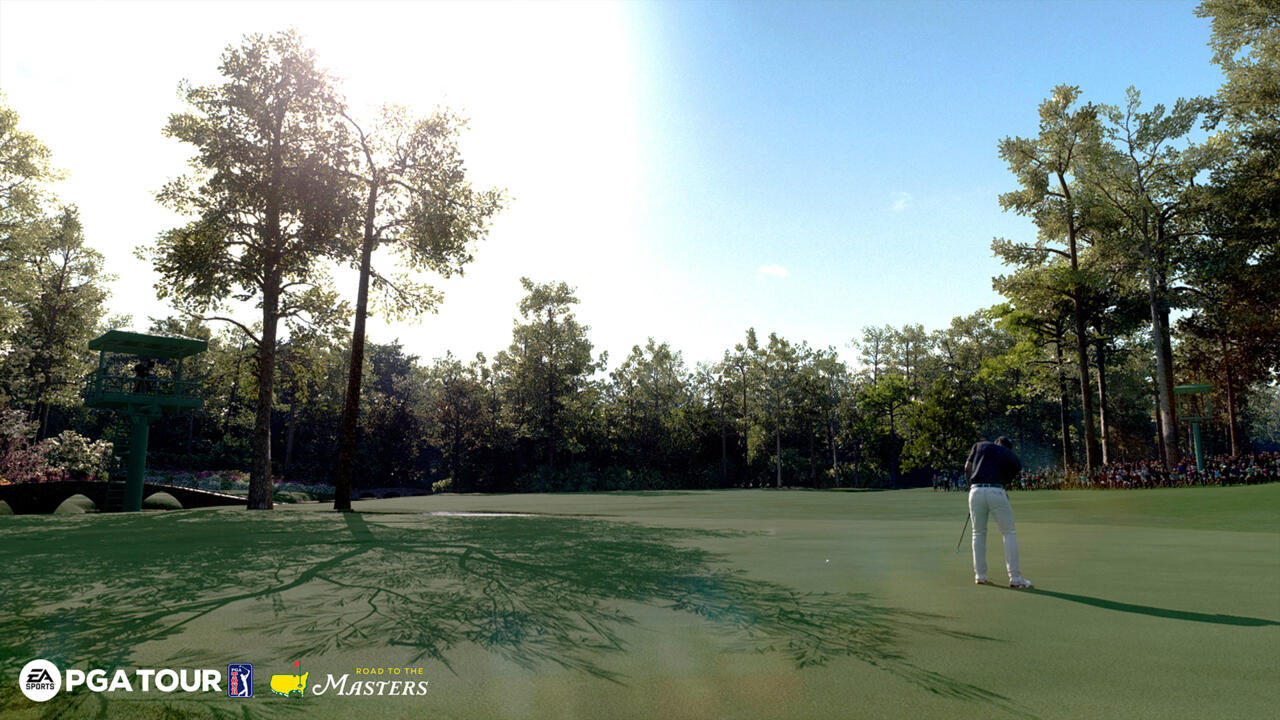EA Sports PGA Tour is unlike any other golf game I've played. It still features familiar elements from the series' past--back when Tiger Woods was front and center--such as slow-motion heartbeat moments and climactic power shots. But after an eight-year hiatus from the world of golf simulation, EA has returned to the fairway with a more demanding recreation of the sport that's as much about feel as it is mastering the game's robust mechanics. With 30 courses covering all four majors--including The Masters at Augusta National--EA Sports PGA Tour has a plethora of golfing action to sink your teeth into. It's just a shame there are a few notable issues in critical areas that hold it back from greatness.
The first of these is the game's swing mechanic. If you've played a golf game before, the actual act of swinging a driver or 5-iron will be familiar. You pull down on the analog stick to bring the club back, then push forward again to unleash your shot. This has been a staple in golf games for a number of years now, and there aren't any alternatives at the moment--not until a three-click system is implemented in a later update. The issue with EA Sports PGA Tour is that there's a slight delay between your input and the on-screen visual. Your swing isn't 1:1, so there's an uneasy disconnect where you never quite feel like you're in total control. The general malaise of each swing doesn't help matters either, with the slow, clunky pacing and frustrating lag making it difficult to nail the timing and power of each shot. I eventually grew accustomed to these idiosyncrasies over time, but it never feels quite right and fails to capture the satisfaction that hitting a 300-yard tee shot should achieve.
To compound the issue, EA Sports PGA Tour also lacks any sort of meaningful tutorial. There are tooltips that pop up and cover the basics the first time you play, but these brief snippets barely scratch the surface of everything going on under the hood. Instead, the game has a suite of challenges that happen to include a Coaching Academy. This is the best place to start, even if these challenges still neglect to offer any tips or feedback to help you along the way. What you get is a variety of contextual situations covering different aspects of the sport, from putting downhill to dealing with elevation changes and the multitude of shot types on offer. There's a lot of trial and error involved, but the repetition of replaying each situation does give you a greater understanding of how everything works. It's not a very user-friendly approach, but it sets expectations and is genuinely helpful in an unconventional way, even if it might prove frustrating for some. Plus, completing these challenges also earns you XP that can be used to improve your created character.

EA Sports PGA Tour's career mode sits front and center, starting off with your no-name golfer competing in the qualifying school before moving on to the amateur Korn Ferry Tour. The ultimate goal is to reach the PGA Tour, which can be done either by winning one of the many four-round courses or by placing highly enough in the Korn Ferry rankings come season's end. You can expedite this process by opting for a quick play mode where you only need to play a few holes rather than an entire round, but I think playing full rounds is the way to go. That's mostly because it gives you ample time to fine-tune your skills, learn the courses, and gain a better understanding of the game's mechanics. There's also a palpable sense of progression that comes from leveling up your golfer. Earning XP lets you build your skills in driving, approach play, short game, and putting, while progressing each attribute also unlocks more shot types, giving you additional options when preparing to send the ball careening toward the green.
Fortunately, the Coaching Academy includes challenges for each of the game's myriad shot types, giving you the opportunity to see how each one functions before playing competitively. There's value in understanding the differences between a runner, spinner, or knock-down shot, but knowing when to utilize each one essentially comes down to a matter of feel. In this respect, EA Sports PGA Tour resembles the sport of golf more accurately than any other game. There are a number of variables at play for every single shot, to the point where there's a real thought process behind each swing. You have to choose the right shot type and club for each situation, adjust for wind and elevation, judge how much power you need to put into the swing, and account for the distinct ways each course plays--tweaking your shot shape depending on the shape of the fairway and lie of the bunkers. The game helps to some degree by displaying relevant information such as wind speed and distance, but then you're left to your own devices. This can be frustrating, particularly early on when you're still learning the ropes and your golfer's attributes aren't up to snuff, but once everything clicks, EA Sports PGA Tour plays an engrossing game of golf that can be incredibly rewarding.
Much of this is down to the courses themselves. Every single one of the 30 officially licensed courses is staggeringly beautiful and offers an authentic attention to detail, whether it's Liberty National and its view of the Manhattan skyline, the waves crashing against the sand at Pebble Beach, or the alligators lurking in the water at TPC Sawgrass. Almost every course is iconic on some level, and they've all been faithfully rendered and recreated, right down to individual blades of grass. The absence of a course designer is a tad disappointing, but unlike PGA Tour 2K23, it's not something that feels like a necessity because there are already so many 18-hole delights. The courses are the game's main character, providing the kind of variety and depth to stave off any tedium. Mastering a golf game's mechanics is usually the key to success, but EA Sports PGA Tour's courses demand much more from you. Each one plays differently, whether it's the roll of the green or the width of the fairway impacting your decision-making. It genuinely feels like you're playing against the course rather than the shot meter.

The physics model, which is built around the official TrackMan data for ball tracking and swing analysis, is excellent for the most part. However, there are some inconsistencies when it comes to ball rollout. On The Old Course at St Andrews, for instance, the rollout is overly extreme to the point where the ball will roll uphill at pace, even through heavy rough. This forces you to account for situations that shouldn't really occur. Once you land on the green, putting is also equally aggravating for different reasons. Each green contains a grid that uses moving beads to show you the direction of the break. The problem is that sometimes this data is inaccurate and the break is opposite to what the beads are showing. The putt reader alleviates this somewhat by showing the ideal path to the hole, but this is also misleading at times. With no reliable way to gauge the breaks, putting is a lesson in irritation that will only be rectified if these issues are fixed in future updates.
Outside of career mode, EA Sports PGA Tour also features various tournament options for use in online matches against the community. If you want to play against friends, however, stroke play is the only option, and there's a disappointing lack of alternating play for those who want to see each other tee off. A range of daily, weekly, and seasonal tournaments give you another chance to earn XP and items like club specs and in-game cash for a limited time before they're refreshed, so there's an incentive to keep coming back. That in-game cash can be spent in a store of rotating items including various cosmetics, which holds some appeal because the character creator is extremely barebones. Outfitting your golfer in branded clothing can be fairly costly, though, which is explained by the inclusion of microtransactions for those who would rather buy the in-game currency with real money. This isn't a surprising move, but it doesn't exactly vibe with the serene mood.
After almost a decade away from the sport, EA's return to the golf course is a promising one. The range of shot types, courses, and tangible variables make for a methodical and tactical game of golf that's both challenging and rewarding. It stumbles by barely introducing players to its robust mechanics, while a laggy swing and inconsistent putting are notable flaws on what is otherwise a fantastic golf sim. EA Sports PGA Tour represents a solid re-entry for the series and lays down a sturdy foundation for an auspicious future.
































